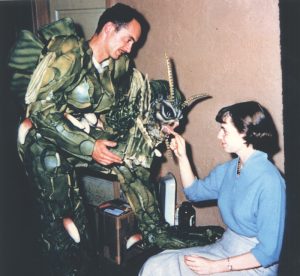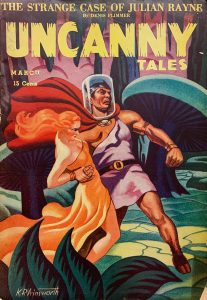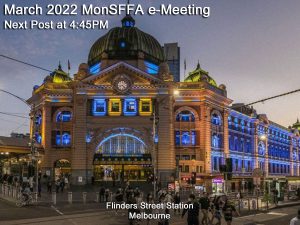10) Sci-Fi Balderdash, Kinda, Sorta
We’ll be on Zoom for the next half-hour playing a sci-fi version of Balderdash, kinda, sorta! For you non-Zoomers, here’s a taste of what we have planned in the coming months:
First of all, we’re working on booking a couple of guest speakers, one who will talk astronomy, the other speaking on selling your SF/F “fancraft” on Etsy. We’ll confirm dates as soon as we have that all figured out.
Also, we have a presentation planned on the brief Hollywood career of artist and sculptor Paul Blaisdell, fondly remembered by fans of mid-century sci-fi cinema for his memorably outlandish B-movie creatures.
In the mid-1950s, Blaisdell earned a reputation among independent genre film producers like Roger Corman for quickly designing and cheaply fabricating movie monsters, leading to his rapid rise and brief reign as the go-to monster-maker among Hollywood’s low-budget sci-fi/horror filmmakers. Often donning his monster suits to play the beasts on screen, Blaisdell’s special effects work was too frequently uncredited, and just as quickly as he rose within the industry, the rapacious nature and changing fortunes of the movie business conspired to drive a disillusioned Blaisdell entirely out of the entertainment field by the early 1960s, never to return.
Today, his then-largely unsung contributions to the field are acknowledged and heralded by modern Hollywood.
We’ll examine, too, the brief history of Canada’s own weird fiction/sci-fi magazine, Uncanny Tales, not to be confused with the American periodical of the same name.
During World War II, the Canadian government introduced the War Exchange Conservation Act (WECA), restricting trade in non-essential goods in order that, as much as possible, Canadian dollars be held in reserve within Canada to support the war effort. Among the products barred from importation were the popular American comic books and pulp magazines of the day, prompting Canadian publishers to seize an opportunity and fill suddenly empty newsstand shelves with homegrown alternatives.
Birthed during this period were a cavalcade of Canadian comic book crime-fighting adventurers and superheroes like Canada Jack, Nelvana of the Northern Lights (pre-dating Wonder Woman), Iron Man (pre-dating by more than two decades the Marvel Comics character of the same name), Captain Wonder, Cosmo, and many others.
Most notable of the science fiction and fantasy pulps resulting from this unique Canadian publishing phenomenon was Uncanny Tales, boasting not merely the reprinted stories of American and British writers, but fresh fiction penned by Canadians.
A colourful, Toronto-based middleweight-boxer-turned-scribe named Thomas P. Kelley, who fashioned himself “King of the Canadian Pulp Writers,” was the most prolific of these authors. Under his own name and numerous pseudonyms, he would, aided by his wife, Ethel, regularly write a couple or more stories per day, some 100,000 words a week! He provided almost all of the content featured in the early issues of Uncanny Tales!
Uncanny Tales and its contemporaries flourished but their success was short-lived, most of the magazines folding when the trade embargo was lifted after the war ended and American titles returned to newsstands. History has been kind to the Canadian superhero comic books that the WECA era spawned, not so much the pulp magazines, which were not as well regarded. Today, surviving copies of these so-called “CanPulps” are rare and greatly valued among collectors.
At some point, we expect to return to our regular, in-person meetings, but at the moment, we don’t know when that will happen. Note that we do plan to continue with these online gatherings in conjunction with the eventual resumption of our live-and-face-to-face get-togethers.
Coming up momentarily at 4:45PM is the final post of this virtual meeting; answers to the opening Quickie Quiz will be revealed, and our next e-meeting date announced.

